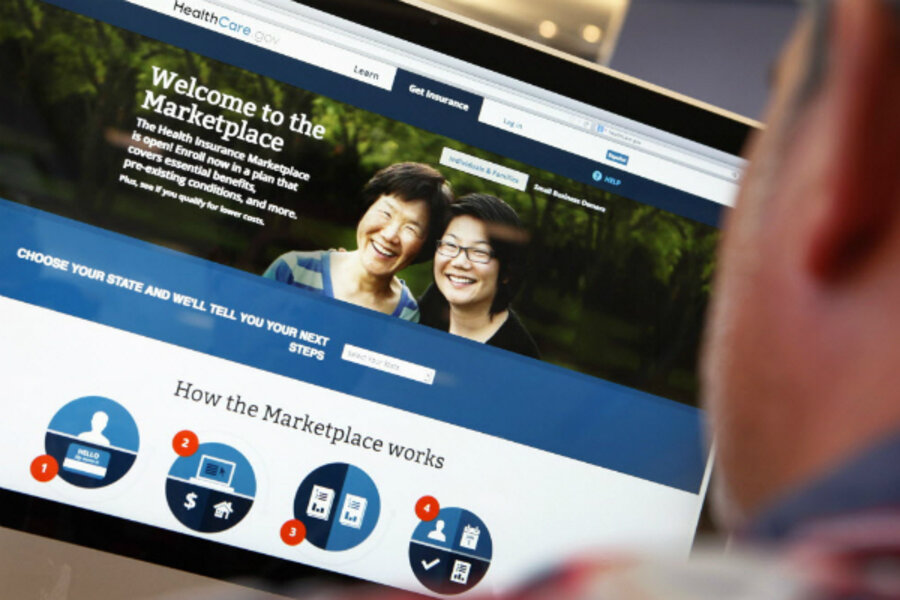Health-care enrollment deadlines shift again; 'Obamacare' uncertainty lingers
Loading...
| WASHINGTON
The Obama administration’s surprise one-day reprieve for people to sign up for health insurance on the federal exchange may bring last-minute insurance shoppers some relief, but it is one in a long list of changes that have generated public confusion about the Affordable Care Act, observers say.
The deadline to enroll for people who still need health insurance (for their coverage to start Jan. 1, 2014) was to be the end of Monday, Dec. 23. Now it is Dec. 24. Previously, it was Dec. 15. Officials around the country site a surge of applicants leading up to and including what was thought to be the Monday deadline.
But nearly three months after the botched initial rollout of the HealthCare.gov website, where people can go to shop for insurance plans, much uncertainty still clouds the program, with both individuals and the insurance industry wondering how “Obamacare” will affect them.
“Where we are is a lot of public confusion, with disappointingly low enrollment and a clear need to continue enrollment efforts and to continue public education throughout the year,” says John Rother, chief executive officer of the National Coalition on Health Care, which has been working for comprehensive health reform for more than two decades.
He suggests that 2014 will be a transition year. “We won’t really have a fully functioning, fully enrolled program until a year from now," he says.
Some critics question whether wobbly Obamacare will ever find its sea legs. An unexpected number of changes in the law’s implementation is feeding the confusion and uncertainty:
Canceled plans. Last week, the Obama administration announced that individuals whose current health plans were discontinued as of 2014 because they didn't meet the law’s new coverage standards will not have to pay a fine if they cannot afford an ACA-compliant plan this year. This "hardship exemption" means, in effect, that the new individual mandate to buy insurance will not apply to them in 2014. These people are also allowed to buy less costly, stripped-down "catastrophic" insurance – a type of coverage that previously was limited to those under 30 years old.
The administration maintains that the change will affect only a small segment of the population. (Of the roughly 4 million people whose plans were canceled, fewer than 500,000 have not found suitable coverage.) But the move represents the first chipping away of the individual mandate, which is needed to make the program actuarially sound.
“This latest rule change could cause significant instability in the marketplace and lead to further confusion and disruption for consumers," said Karen Ignagni, president of America's Health Insurance Plans, in a statement.
Shifting deadlines. Because enrollees lost the months of October and November when HealthCare.gov wasn’t working very well, the Obama administration and the participating insurers negotiated a delay in deadlines to enroll and make a first payment on the premium – from Dec. 15 to Dec. 23 (now Dec. 24) to enroll, and from Jan. 1 to Jan. 10 to pay the first premium. To add to the confusion, this month is the deadline only for people who want coverage to start on Jan. 1. Other consumers still have until March 31 to buy coverage and still avoid a penalty in 2014.
Changes on top of other changes. In July, the White House announced a one-year delay in the “employer mandate” that requires businesses with more than 50 employees to provide coverage or pay a fine. Then, in November, it also gave a reprieve to small businesses, saying that these employers do not need to offer their workers online enrollment until 2015.
At his press conference Friday, President Obama said more than 1 million people had purchased health insurance through the federal and state websites. But in September – before the botched rollout of HealthCare.gov – 3.3 million had originally been expected to sign up by this time.
About the only certain thing for the program will be its continued politicization, with Republicans – and even some Democrats – decrying it, and the administration working to improve and defend it.








